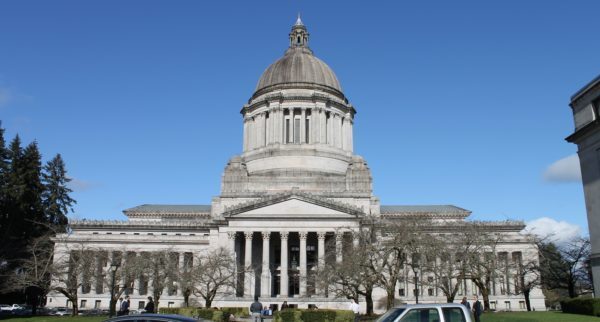
Democrats controlling the Washington capitol may have a dilemma if they’re asked to deal with an increase in the presence of THC found in drivers involved in car crashes. (Dave Workman)
A new study released by AAA this week reveals that an increasing number of drivers involved in fatal Washington State car crashes testing positive for THC has doubled since recreational marijuana use was okayed by voters in 2012, as reported by KING 5 News, the NBC affiliate in Seattle.
Authorities in New York are paying attention because there’s a move to legalize recreational pot use in that state, according to CYNCentral.com.
The AAA study shows that between 2008 and 2012, “an estimated 8.8% of Washington drivers involved in fatal crashes tested positive for THC.” But between 2013 and 2017, the percentage climbed “to an average of 18 percent.” According to an AAA chart, the percentage went up a startling 21.4 percent, the highest rise over the five-year study period.
Democrats in control of the Washington Legislature now have a dilemma. Should they crack down on pot the same way they are determined to restrict the rights of gun owners? Smoking weed is popular among their core constituent base, owning guns, not so much.
As noted by a report at OregonAAA.com, “In the five years before (recreational pot) legalization, an average of 56 drivers involved in fatal crashes each year were THC-positive. In the five years after legalization, the average jumped to 130.”
That’s more than a 100 percent increase.
Democrat lawmakers in Olympia are keen on banning so-called “assault rifles” and institute training requirements for concealed pistol licenses. Data from the FBI uniform Crime Reports from 2014 to 2018 show rifle use in Washington homicides has remained rather static in the 2-to-4 percent range, with one aberration in 2016. That was the year of the Mukilteo and Cascade Mall shootings, both involving rifles, that bumped the number up.
In 2014, the FBI data shows 6 of the state’s 94 gun-related slayings are known to have involved rifles. In 2105, only 3 of the state’s 141 gun-related murders are identified as involving rifles. In 2016, the number jumped to 11 to include the 8 victims of the two attacks. In 2017, the number came right back down with only one (1) of the 134 gun-related murders involving a rifle, and in 2018, the FBI crime report for that year identified only 2 of the 138 murders were known to have been committed with a rifle.
The total annual number of gun-related slayings over the five years mentioned above is consistently lower than the number of murders reported in some major cities, such as Chicago, Baltimore or Washington, D.C.
The gun-prohibition lobby likes to argue “More people die from gun violence in Washington state than in car crashes.” That is only true if one adds suicides and accidental shootings to the definition of “gun violence.” Second Amendment activists say that’s a deliberately misleading combination of statistics. The argument falls flat when one compares fatal car crashes to annual firearms-related homicides.
According to data from the Washington Traffic Safety Commission, in 2014, Washington saw 429 car crash fatalities, while 2015 produced 499 crash deaths. In 2016, 504 people perished in car crashes, and in 2017, that number climbed to 534. In 2018, 491 people were killed in vehicle crashes.
If Evergreen State lawmakers spent as much energy on traffic safety as they do trying to erode the constitutional rights of gun owners, the highways might be as safe as, say, a typical gun range, where there is rarely a fatality, or a typical gun show, where there haven’t been any shootings, fatal or otherwise, in recent memory.
Lots of people advocate for marijuana, especially when used for medical relief. That’s not the point of this particular argument. While recreational pot use has been okayed in Washington, Colorado and elsewhere, it is still a controlled substance under federal law.